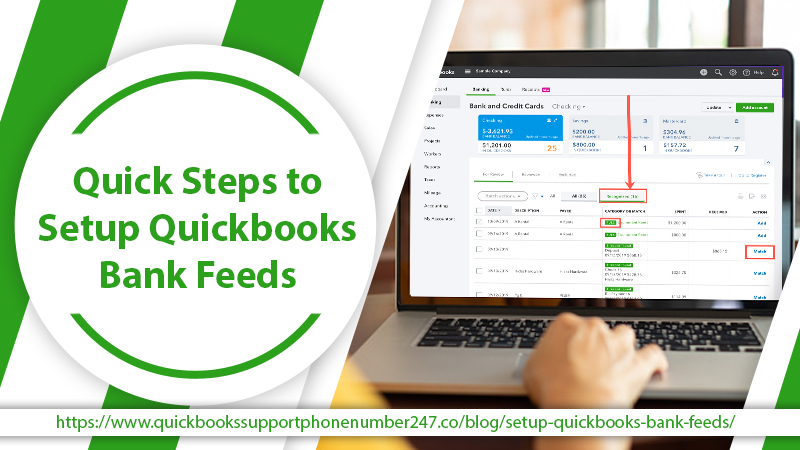Add Bank Account to Setup QuickBooks Bank Feeds

In the following guide, we will learn to setup QuickBooks bank feeds. It’s one of the major concerns of QuickBooks users. They get perplexed while matching transactions.

Quickbooks bank feeds should be matched with your bank transaction. Whether it is the date, time, amount, or account, all of it should be correct in both files. Once you check them, you can add them to Quickbooks Check Register via Quickbooks Online Banking Center.
Moving forward, let’s turn the page to How to Setup QuickBooks Bank Feeds. Let’s get started!
Why Enabling Quickbooks Online Bank Feeds Is Important?
Quickbook is majorly used by small and medium firms. You don’t have all day to sit and enter data manually. Neither would you prefer someone to do so. Especially, when QuickBooks features automatic QuickBooks online bank feeds.
First, it saves most of the time you would spend on entering your financial transactions single-handedly. Next, you don’t have to worry about mistakes you would have made in entering data manually.
Although you can manually enter transactions that would be hectic. Therefore, enabling live QuickBooks bank feeds is a favorable option for anyone. You will get the transactions quickly on your bank feed.
Does Enabling Live Quickbooks Bank Feeds Impact Your Security?
Let’s just burst the myth here that many QuickBooks users have about QuickBooks online bank feeds.
They hesitate to use live QuickBooks bank feeds. They believe their data will not be secure if it goes on the web automatically.
That’s not true! Quickbooks is also popular for its security measures. It places a read-only option when the data is placed online.it has one-way communication that is ‘read’.
In simple words, when your financial transactions are transferred to the software, they will only be stored. Neither the software nor the server can process or obtain any personal details of your business.
How to Setup Bank Feed in Quickbooks Online?
Now that you are ready to set up a bank feed in QuickBooks online, the first step is to have a QuickBooks account. Have you created one or if not, create a Quickbooks account for each bank account you want to add to QuickBooks.
But, if you wonder, How to set up QuickBooks Bank Feeds to your account chart in Quickbooks? Find the steps below.
Add a Bank Account in Quickbooks in 10 Minutes
Follow these steps for each account you want to add to your QuickBooks account charts. Later, you can import your bank feeds into QuickBooks.
- First, head to the Company and select Charts of Accounts.
- Then, tap on Account and select New.
- Select Bank by tapping on the continue button.
- Enter your bank account name and for help, you can click on the ‘select from examples’ button.
- In the next step, you can mark your account as a sub-account of another.
- Then, write a short description so you will know which account it is.
- Now, enter your bank account number.
- Then proceed by entering the routing number.
- If you are a tax professional, you can choose a Tax-Line mapping (or skip it).
- After that, enter an opening balance. Use the drop-down calendar to select the date of the balance.
- Review all the above information entered once and if correct, click Ok.
- Then, Save and close the account window.
- Saving the details of the new account you will receive a prompt asking if you want to enable live banking QuickBooks. Select Yes or follow the next section to get the transactions of the bank account in QuickBooks.
Enable Live Bank Feeds Quickbooks
Follow these steps to set up bank feed in QuickBooks online explained below. Follow them carefully to enable live bank feeds in QuickBooks.
- Launch QuickBooks.
- Head to Banking.
- Then, from the landing page, select Connect Account.
- If you already have an account, select Upload Transactions.
- Now, search your bank and when you find it, tap on it.
- As soon as you select your bank, you will be shifted to a new screen saying “direct connect.”
- All banks have their strategy and process, thus, make sure you contact your bank first on allowing a QuickBooks connection.
- After you connect your account, select continue.
- It will ask you to log in to your account. You may have to use a login id and password depending on your bank policy.
- Click connect.
- Now, you will get a list of all your bank accounts on the screen and choose the bank account you want to add to QuickBooks.
- Tap on the option connect and your bank account is connected to your QuickBooks account.
To access the bank account feeds, go back to the Bank Feeds Center, it will fetch the transactions automatically.
Now, you can match the bank feeds of QuickBooks with your bank transactions easily.
Also Read : QuickBooks migration tool
Winding up!
The following guide has provided you with all the steps required to setup QuickBooks bank feeds. Thus, make sure you read them carefully and follow them in series.
If you get a problem, go back to the guide and see if you have missed any steps. Nonetheless, feel free to contact our QuickBooks professional if the issue persists and you cannot set up the bank feeds in QuickBooks successfully.